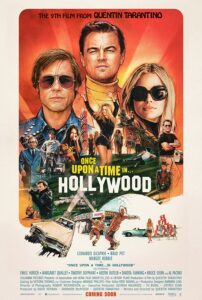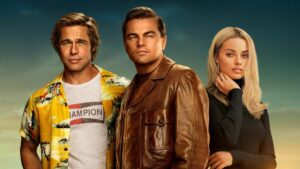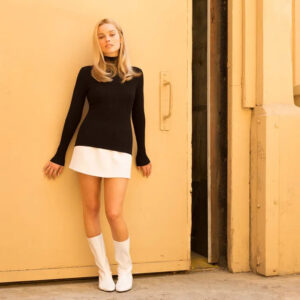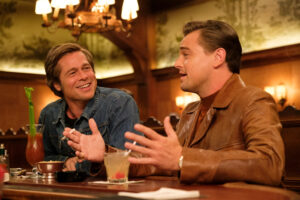“Once Upon a Time… in Hollywood” – Today Real Cowboys are Gone

Title: “Once Upon a Time… in Hollywood”
Release Date: 2019
Director: Quentin Tarantino
Cast: Leonardo DiCaprio, Brad Pitt, Margot Robbie, Al Pacino, Margaret Qualley, Mike Moh, Kurt Russell, Damian Lewis, Rafał Zawierucha
“Once Upon a Time in Hollywood” is a movie in which Quentin Tarantino goes back to the 1960s to show a turning point in the history of cinema and the Dream Factory. He interestingly portrays the cream of Los Angeles at the time, employing top stars headed by Leonardo DiCaprio, Brad Pitt and Margot Robbie. All the typical features of Tarantino’s style can be found here: playing with film quotes and characters, a mixture of seriousness, grotesque and comedy or deconstruction of cinematic violence. Nevertheless, the most interesting thing about this film for me is the specific diagnosis that the director boldly serves to the audience. Tarantino says that the old era of American cinema ended with the destruction of the model of traditional masculinity: the strong cowboy. And he shows what would have happened if not all cowboys had become irretrievably extinct after all.
“Once Upon a Time in Hollywood” – In the Dream Factory of the 1960s.
The main character of “Once Upon a Time in Hollywood” is a certain Rick (Leonardo DiCaprio), a once-famous western actor who, after a long absence from America in 1969, returns to the Dream Factory with his understudy Cliff Booth (Brad Pitt). The man is completely unable to find himself in the new reality. The Vietnam War is underway, and hippies are roaming the streets. There are no more suitable roles for him and he has to make contacts in the industry anew. He quickly realizes that the biggest rising star is Roman Polanski (Rafal Zawierucha), who is just cutting the coupons from his famous film Rosemary’s Baby. Along with his beautiful wife, Sharon Tate (Margot Robbie), he’s clowning around at California parties, with everyone vying for his attention.
Rick, too, dreams of getting in touch with Polanski, so he rents a villa in Beverly Hills, right next to his stately estate. In his own words, by the way: “Real estate in Hollywood means that you live here, not that you came to visit, but that you k… live here” He also tries to get a job as a stuntman for Cliff, but the latter, due to his impulsive character, gets into a fight with Bruce Lee and is thrown off the set. One day on the outskirts of Los Angeles, Cliff meets a teenage girl who takes him to an old farm where the mysterious “Family” – a sect of Charles Manson – resides. Cliff quickly realizes that this is not a friendly place….

“Once Upon a time in Hollywood” – Tarantino and his actors
“Once Upon a time in Hollywood” is a movie that will appeal to lovers of Tarantino’s cinema, because, as usual, the director’s trademark is evident here. The filmmaker not only plays with mixing genres: thriller, comedy, horror, but also with intertexts from his own oeuvre. We can see the reference to earlier films already at the level of the credits, here made in the characteristic yellow “western” font. In the serial roles of Rick “The Law of Fists” we find references to “Django” and “The Hateful Eight.” The hero’s other film, where in the climactic scene he uses a flamethrower to kill Nazis in a movie theater, meanwhile, obviously refers to “Inglourious Basterds.”
As usual, too, one of the greatest assets of a Tarantino movie is its actors. This time there is a great trio: Leonardo DiCaprio, Brad Pitt and Margot Robbie. The former brilliantly played an actor whose fame has faded, and he is trying to get back on the main track. Brad Pitt, rightly awarded an Oscar, brilliantly played the tough stuntman, enduring all the inconveniences of fate with a stony face and offering support to his closest friend. Margot Robbie, on the other hand, is the perfect embodiment of Sharon Tate: lovely, delicate, charming and stunningly carefree.
Her innocent joy, always accentuated by the cheerful musical commentary accompanying her scenes, strikingly contrasts with the tragic story of this character. The actress’ candy-colored portrayal focuses all the fairy-tale aspects of this, but also of any potential film story. Indeed, its fictionality is indicated by the very title of Tarantino’s picture, which is a popular phrase that begins fairy tales: “Once Upon a Time…” or “Once upon a time…”/ “Once upon a time…”.

“Once Upon a Time… in Hollywood” – the immortal climate of the 1960s.
Tarantino’s movie “Once Upon a Time in Hollywood” is certainly a great reconstruction of the climate of the 1960s. We take a kind of trip back in time to get into his little MG TD with Polanski (long shots from the perspective “from the back seat” are a kind of leitmotiv of the film). In addition, the iconic brands of the time appear on the road: Cadillac Coupe, Volkswagen Karmann Ghia or Lincoln Continental. Of course, we can saturate our eyes to our heart’s content with the fashion of the late 1960s. Especially Margot Robbie impresses in a beautiful snake skin coat, a yellow costume consisting of a top and shorts or a mini skirt. It is significant that the heroine is always wearing something illuminating, and bright colors, emphasizing her cheerful disposition and sunny California climate.
Of course, it wouldn’t be the climate of the sixth decade of the 20th century without the legendary music of the time. So we will hear “Hush” by Deep Purple, “Kentucky Woman”, the hit “California Deamin” or music by the band Paul Revere & The Raiders. What’s more, original commercials and the weather forecast from the 1960s fly on the radio, and an excerpt from the western “The Judge from Texas” is also an important part of the musical commentary. Significantly, the film features authentic characters alongside fictional ones. So in addition to Polanski and Sharon Tate, for example, appear Steve McQueen (Damian Lewis), Michelle Phillips and Jay Sebring (Emile Hirsch). They all party together at a party at the famous Playboy Mansion.
“Once Upon a time in Hollywood” – a crisis of the traditional pattern of masculinity
But what is Quentin Tarantino’s long, nearly three-hour film primarily about? Is it simply a tribute to an old, irretrievably past era of American cinema, which was interrupted by the brutal murder of the Manson cult? I’m convinced that, as usual, this director’s project goes far beyond the showy marriage of iconography, music and witty dialogue. Namely, Tarantino shows a watershed moment not only in the history of cinema, but of American culture as a whole. This is the period when the western, the story of the birth of America, goes into decline. And with it, the pattern of the real man is going through a crisis: the tough Wild West cowboy. His embodiment is Rick, after a bit, but primarily Cliff Booth. He is the one who represents the uncompromising traditional values of the old world. This can be seen in a notable scene that has stirred up a lot of controversy, namely the duel with Bruce Lee himself (Mike Moh). It can be read as a kind of confrontation between the American cowboy and Eastern role models.

Cliff’s traditional value system is emphatically highlighted when a man drives a teenage girl he met along the road to a farm near Los Angeles. Contrary to appearances, Booth is not fooled by the girl’s insidious charms; he suspects from the start that she is underage, which sets impassable boundaries for him. The opposite of traditional masculinity, on the other hand, in “Once Upon a Time in Hollywood” are the hippies who represent a completely new cultural model and the characters who sympathize with them.
Almost symbolically this is shown in the scene at the Playboy mansion party, when Steve McQueen and a friend observe the amused Sharon, and in the conversation the telling words are uttered: “One thing is certain. Sharon has her type: cute, short, talented boys who look like twelve-year-olds”. They are the ones who supplant the tough cowboys and the traditional value system they represent. And what if some of the old toughs had survived after all? Perhaps things would have turned out differently. How? To find out, you have to watch “Once Upon a Time in Hollywood” to the end.
